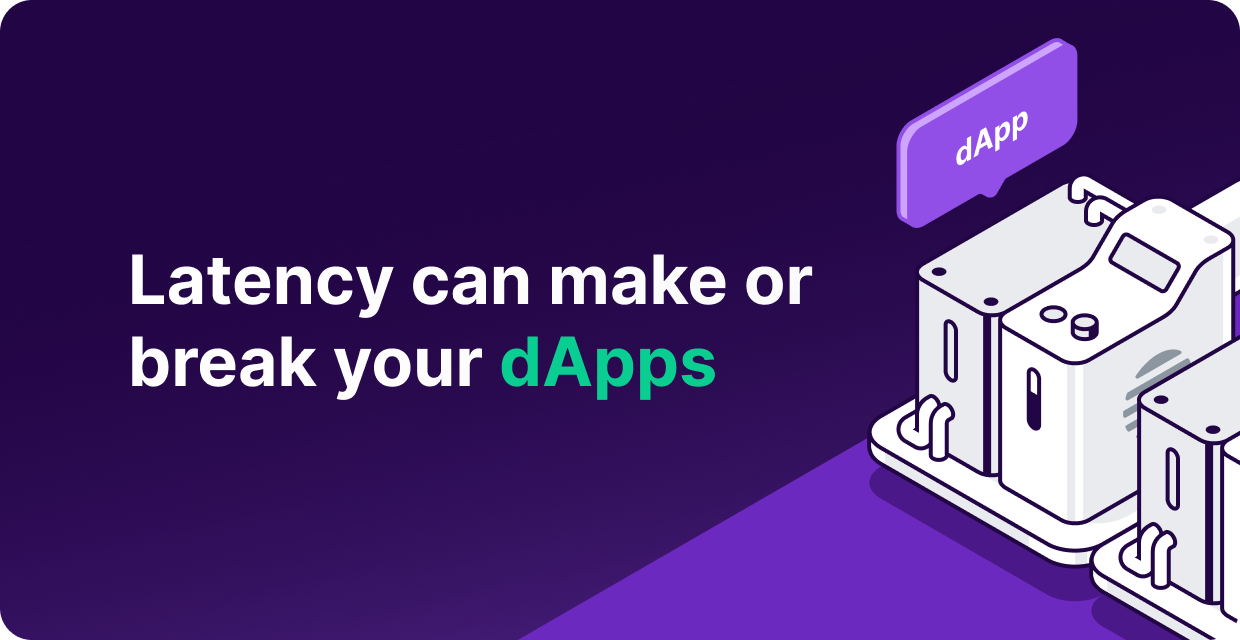Latency Can Make or Break Blockchain Applications—How To Speed up Your dApp
Enhancing the speed of decentralized applications (dApps) is critical for user engagement and trust. Latency can significantly impact user experience, leading to frustrations and potential loss of users if transactions lag.


The need for speed in dApps (decentralized applications) goes far beyond mere user convenience.
Have you ever clicked "confirm" on a dApp transaction and felt that frustrating lag? That’s latency at work and it can really impact users’ experience. Low latency isn’t just about speed—it’s about trust. When a dApp responds instantly, it keeps users engaged and confident. But if there’s a delay, they’re already jumping to your peers.
Every interaction with the blockchain — whether it's checking token prices, querying wallet balances, or validating transactions — demands real-time responsiveness.
This isn't just about providing a smooth user experience; it's about maintaining the integrity and functionality of the entire system.
This blog covers what latency means in the context of dApps, what metrics to track, how to improve dApp performance, and how QuickNode can aid in fixing latency.
What is Latency in Blockchain Nodes or Web3 Infrastructure?
Latency is the time delay between initiating a transaction and finalizing the state change. For instance, when a user hits the 'swap' button on Uniswap, the time gap it takes for the user's wallet balance to change is latency.
The time delay — latency in blockchain node infra is multi-faceted and can be segmented into three main categories: Network, Processing, and Consensus.

Network Latency
Network latency is the time it takes for data to travel across the blockchain network.
The common causes are:
- Query response time: Time taken for a node to process and respond to a data query.
- Transaction propagation: Time for a transaction record to spread across the network.
- Message propagation delay: Time for messages like new block announcements to be propagated to all nodes.
Processing Latency
Processing latency is the delay in executing operations within individual nodes while validating and processing transactions.
The common causes are:
- RPC response latency: Delay in receiving responses to RPCs made to nodes.
- State synchronization: Time needed for nodes to update and sync with the network.
- Memory pool (mempool) processing time: Delay in processing transactions waiting in the mempool.
- Indexing delay: Lag in updating indexed blockchain data for efficient querying.
Consensus Latency
Consensus latency refers to the time required for the network to reach an agreement on the state of the blockchain.
The causes of consensus latency are:
- Block confirmation: Duration between a transaction's inclusion in a block and its network-wide confirmation.
- Node synchronization: Time for a new node to sync with the entire blockchain data and history.
- Peer node discovery: Time for a node to establish communication with other network nodes.
How Does Latency Impact dApps and DeFi Protocols?
Latency is crucial for dApps and DeFi (decentralized finance) protocols due to its impact on functionality, security, and user experience.
Here are three cascading effects of high latency that can be catastrophic for DeFi protocols and dApps:
Data inconsistencies and blockchain integrity
High latency can cause variations between the actual state of the blockchain and what's reflected in the dApp. This can lead to incorrect balances being displayed, transactions appearing to fail when they've actually succeeded, or vice versa.
Information arbitrage
In fast-moving markets, latency creates windows of opportunity for programmed bots, algorithm traders, and big players (whales) to exploit price discrepancies. Slow updates in market data lead to front-running of transactions which is harmful for average users.
Time-bound security risks
High latency exposes protocols to risks like flash loans and sandwich attacks, where malicious actors exploit time-sensitive transactions before they are fully confirmed. It also compromises the effectiveness of critical security features such as circuit breakers and emergency shutdowns.
3 Latency Metrics dApps Need to Track
To track dApp speed and performance, here are three latency metrics that you should start tracking for your dApp:
RPC response
RPC response is the time taken for a blockchain node to respond to a request a dApp makes. This measures how quickly the dApp can retrieve or send data to the blockchain.
A faster RPC response ultimately leads to a dApp with:
- Improved user experience and dApp responsiveness which reduces users' wait time.
- Accurate real-time data are essential for DeFi protocols.
- More smoother dApp functionality without any timeouts or slippage errors.
Nodes sync
Node synchronization is the ability of nodes to stay in sync with the latest block. This metric is crucial to ensure that the dApp is functioning in alignment with the latest blockchain state.
Perfectly synchronized nodes mean a dApp works with,
- Data consistency and accuracy across the network.
- No security vulnerabilities from outdated information.
- High integrity of smart contract interactions.
Requests per second (RPS)
RPS is the number of requests the blockchain node (or API) can serve per second. This metric reflects a dApp’s scalability and performance under load.
Node infra with higher RPS,
- Increase the dApp's ability to handle high user traffic, thereby improving scalability.
- Prevents bottlenecks during traffic spikes, such as during NFT mints or airdrop claims.
- Improves the feasibility of complex, multi-query operations.
QuickNode Streams can deliver blockchain data like blocks, receipts, logs, and traces at a rate of 100,000 RPS.
5 Strategies for Improving dApp Speed and Performance
Now we know which latency metrics to optimize for to improve performance and speed in dApps and DeFi protocols. Let’s understand how to put that into practice with these five strategies:
Optimize RPC node performance
Deploy dedicated nodes exclusively for your dApp to avoid performance degradation caused by shared resources. Also, regularly monitor node performance and resource usage to ensure they meet your dApp’s demands. Moreover, implement node clustering i.e. set up multiple nodes within a cluster to handle increased traffic and ensure high availability.
Going one step further, you can also use load balancers to distribute traffic evenly across nodes, preventing bottlenecks.
QuickNode Clusters allow developers to dynamically scale infrastructure, maintaining consistent performance even during high-traffic periods, directly addressing RPC response time and requests per second metrics.
Implement caching
Implementing caching is key to optimizing dApp performance. Identify frequently accessed data (e.g., user profiles, metadata) that doesn’t change often and store it off-chain in a caching layer like Redis or Memcached. This reduces the load on blockchain nodes and accelerates data retrieval.
QuickNode’s Core API enables developers to cache frequently accessed data off-chain, minimizing repetitive blockchain queries and speeding up response times. This approach not only improves efficiency but also ensures high availability and performance consistency across your dApp.
Optimize data access and retrieval
Optimizing data access and retrieval is crucial for dApp performance. Analyze your database queries and identify which fields are frequently queried. Create indexes for these fields to speed up data retrieval, especially for complex dApps that handle large datasets.
Implement query caching to store the results of common queries. This avoids repeated database calls and reduces latency. When you do this, it allows developers to maintain high performance and efficiency without sacrificing speed.
QuickNode Streams offers real-time data streaming with built-in indexing and query caching ensuring quick access to frequently queried data.
Efficient RPC endpoints
Efficient RPC endpoints are crucial for reducing latency and optimizing dApp performance.
Combine multiple related requests into a single batch to minimize the number of round-trips between your dApp and the blockchain. Also, identify the most efficient RPC endpoints for your dApp’s needs. Avoid redundant or unnecessary data requests by fine-tuning your queries to fetch only the required information.
This approach is particularly valuable in high-latency environments, ensuring that your dApp operates smoothly with minimal delays.
QuickNode RPC API offers a globally distributed network of nodes, ensuring that requests are routed to the nearest available node. Plus, QuickNode maintains a high block-height recency ensuring that its nodes are always in sync with the latest blockchain data. This setup reduces latency and offers faster response times.
The RPC infrastructure is also designed to auto-scale based on traffic demands and includes failover mechanisms to ensure uptime and reliability.
Offload computation
Offloading computation to decentralized storage and edge functions can enhance dApp performance by reducing blockchain load.
Store large files, such as images or videos, on decentralized storage solutions like IPFS or Arweave. This reduces the burden on your blockchain and improves retrieval speeds.
You can do this using QuickNode's IPFS service which is a scalable and reliable way to store and retrieve data using InterPlanetary File System (IPFS). It offers decentralized storage that allows developers to store files securely and distribute content globally without relying on a single point of failure.
Similarly, offload computationally heavy operations to edge functions that run closer to the end-user. This reduces the load on the main blockchain and improves responsiveness by processing data at the network edge.
Employ QuickNode's Functions for serverless edge computing tailored to blockchain data. This service allows developers to deploy code closer to the node, improving performance and reducing latency. With support for Node.js, Python, and blockchain SDKs, functions can filter, transform, and enhance blockchain data in real time.
Functions are deployed instantly, with auto-scaling and global load balancing, making it easy to handle high-traffic loads efficiently.
Latency in Numbers: Comparing QuickNode with Other Blockchain Node Providers

In 2022, we made a detailed comparison of the response time of major blockchain node providers.
Over 2 weeks, we made around 600k calls to each node provider, covering over 5 million data points, sufficient to make a fair comparison.
Here are some results from that comparison test:
Speed and robustness

Inferences:
QuickNode’s global average response time stood at 86ms, almost 2x faster than the following best.
Geographical stability
Inferences:
QuickNode is the top performer globally and across all regions with an average response time of,
- 45 ms — US
- 74 ms — EU, and
- 155 ms — AP, respectively.
We also ran some latest tests using QuickNode Compare where we went head-to-head against popular node service alternatives, Alchemy and Infura.
Here are the results:
Result:
QuickNode outperforms both Alchemy and Infura in average response time, recording 192.9ms vs. Alchemy's 311.8ms and 202.9ms vs. Infura’s 241.4ms.
Build Faster and Efficient dApps Using QuickNode
Web2 or web3, slow apps with poor user interfaces are destined to lose users to more responsive alternatives.
However, developing high-quality, performant dApps doesn't have to be a marathon effort with 10s of developers and 100s of engineering hours.
QuickNode provides a comprehensive backend solution that comes with ready-to-deploy infrastructure, including robust node services, reliable data access, and edge computation capabilities. Contact us to learn more on how we can help you accelerate your solutions’ time-to-market.

About QuickNode
QuickNode is building infrastructure to support the future of Web3. Since 2017, we've worked with hundreds of developers and companies, helping scale dApps and providing high-performance access to 40+ blockchains. Subscribe to our newsletter for more content like this, and stay in the loop with what's happening in web3!





